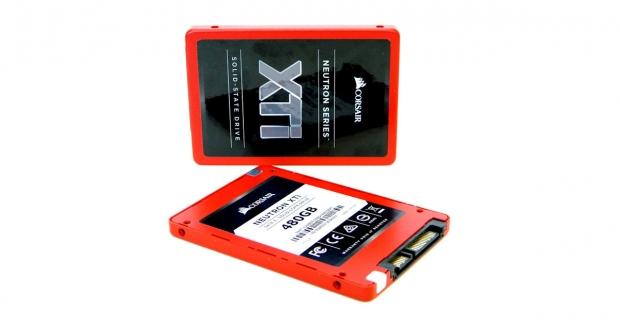
The Bottom Line
Introduction, Specifications, Pricing & Availability
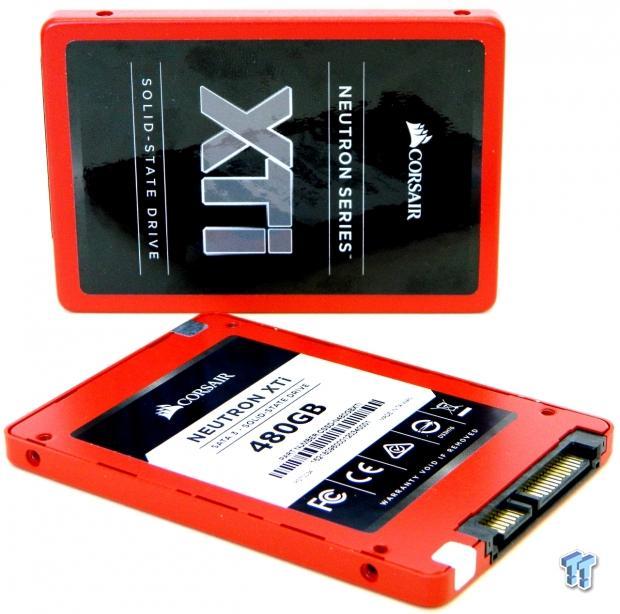
Corsair is a dedicated enthusiast company with a vast portfolio of enthusiast grade products. At this year's Computex, Corsair announced a new flagship SSD; the Corsair Neutron XTi. Corsair has never been shy about going the extra mile to deliver innovative products that push the envelope. Corsair's Neutron XTi is just such a product. As many companies look to increase profit margins by utilizing the bare minimum, Corsair is doing just the opposite with their Neutron XTi series SSDs by doubling the typical DRAM to NAND ratio.
Typically, SSDs that have onboard DRAM caching employ a 1MB DRAM to 1GB NAND ratio. A DRAM cache is used to provide faster access to block addressing; wear leveling data is also kept in the cache while the SSD is operating. The larger the DRAM cache, the better the SSD will perform. The problem is, DRAM is one of the most expensive components on an SSD, which is why most SSDs employ the minimum required to deliver decent performance. Some SSDs do not even utilize a DRAM cache as a cost-saving measure, which in turn significantly reduces overall performance.
Corsair was first to utilize Phision's PS3110-S10-X quad-core 8-channel controller, doing so on their Neutron XT series. Phison's PS3110-S10-X quad-core 8-channel controller, or S10, as we will refer to it going forward, has emerged as the leading third-party SATA III controller on the market. Phison's S10 controller is capable of being paired with TLC or MLC flash arrays in capacities of up to 2TB, making it the most versatile SATA controller on the market today. Phison controllers are among the industry's most reliable with integrated features like End-to-End Data Path Protection, SmartECC, SmartRefresh, SmartFlush, GuaranteedFlush, Advanced wear-leveling and garbage collection.
Corsair's Neutron XT series paired Phison's S10 controller with Toshiba A19nm MLC flash and featured a 1MB to 1GB DRAM to NAND ratio. The Neutron XTi pairs Phison's S10 controller with Toshiba 15nm MLC flash and features double the DRAM cache to NAND ratio at 240-960GB capacity points, which should notably improve heavy workload performance. In addition to doubling the DRAM cache, the Neutron XTi's TBW rating has been greatly increased over the Neutron XT. The Neutron XT carries a TBW rating of 124TB at all capacity points. The Neutron XTi carries a TBW rating of 320TB for the 480GB model and 640TB for the 960GB model; both figures are the highest claimed for any client drive currently on the market.
Corsair is marketing their flagship XTi as an ultra-high performance SSD engineered to meet the most demanding workloads, with several enterprise-like features that meet the needs of hardcore gamers, design professionals, and 4K video content creators. Despite the additional cost incurred by doubling the amount of onboard DRAM cache, the Neutron XTi is priced affordably at launch, especially when you consider the drive is an 8-channel MLC SSD with the highest endurance rating of any client drive on the market.
It's been quite some time since we've seen an SSD that can handle demanding workloads as well as Samsung's 850 Pro. Is Corsair's Neutron XTi up to the task despite its significantly lower price point? Let's find out.
Specifications
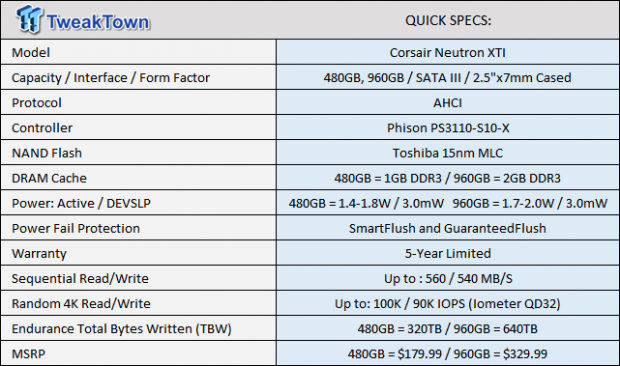
Corsair's Neutron XTi 2.5"x7mm SATA III SSD is available in four capacities: 240GB, 480GB, 960GB, and 1920GB. The 1920GB model will come to market at the end of July and will feature a 1 to 1 DRAM cache to NAND ratio. The 480GB and 960GB models we have on the bench share the following factory specifications: Sequential Read: up to 560 MB/s. Sequential Write: up to 540 MB/s. Max 4K Random Read Speed: up to 100,000 IOPS. Max 4K Random Write Speed: up to 90,000 IOPS.
The Neutron XTi is compatible with Corsair's SSD Toolbox. Corsair's SSD Toolbox provides advanced drive management tools including Monitor S.M.A.R.T attributes and SSD health status. Support for Over-provisioning, Secure Wipe, Disk Cloning, FW update, and more. The most notable feature of Corsair's SSD Toolbox is disk cloning which makes migration to Corsair's Neutron XTi a breeze for the end-user. Corsair backs the Neutron XTi with a five-year limited warranty. The 480GB model carries an MSRP of $179.99, the 960GB model $329.99.
Drive Details
Corsair Neutron XTi 480GB & 960GB SATA III SSD
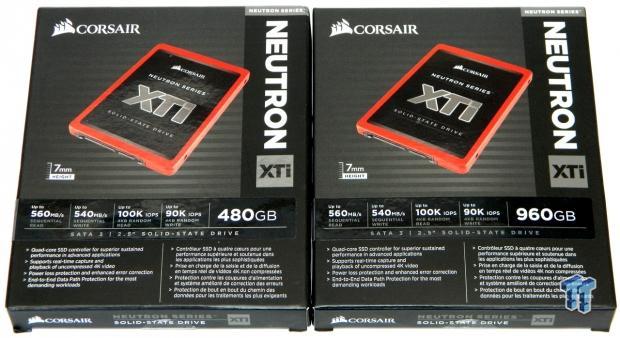
Retail packaging features an image of the enclosed SSD on the front of the box. The front of the packaging advertises the enclosed drive's capacity, sequential performance, random performance, and advanced features.
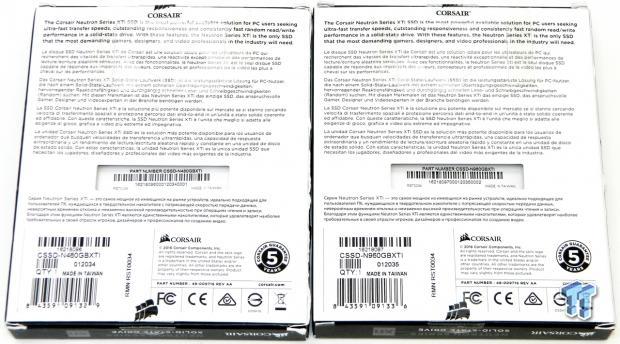
The rear of the packaging advertises the drive's five-year warranty and gives us a quick run-down of usage scenarios where the Neutron XTi will provide a superior user experience.
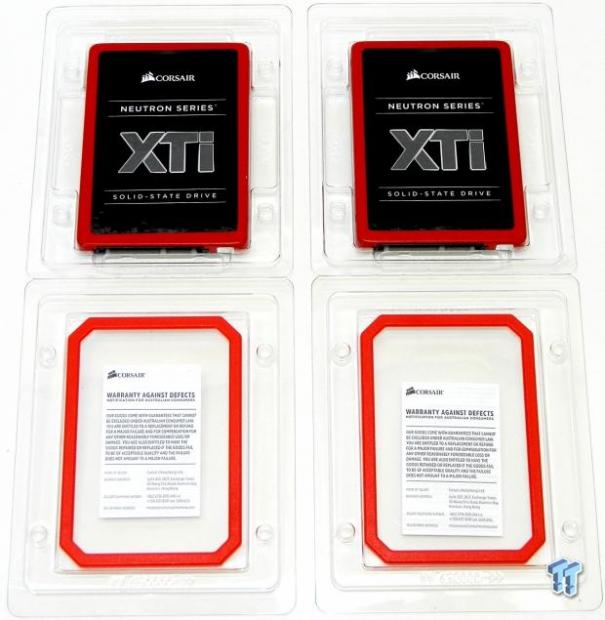
Inside the packaging is the drive itself, a stick-on plastic spacer, and a printed warranty outline. The drive is protected from shipping damage by a clear plastic clam-shell enclosure.

The top of the drive's all red aluminum snap-together enclosure is covered with an attractive label.
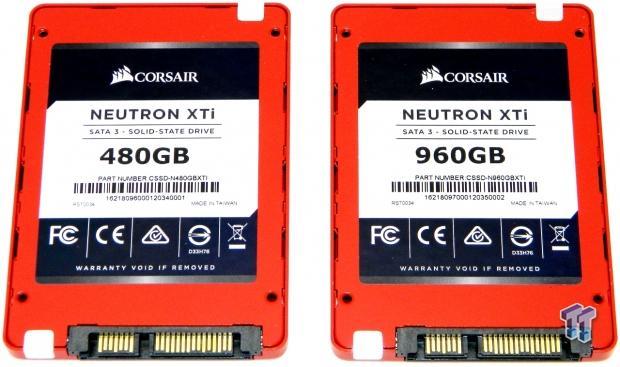
The back half of the drive's enclosure features a manufacturer's label listing the particulars of the drive.

The PCB snaps into place onto the bottom half of the drive's enclosure. The drive's enclosure is a screw-less design.

This side of the PCB houses the drives controller, four BGA flash packages, and a single DRAM cache package.
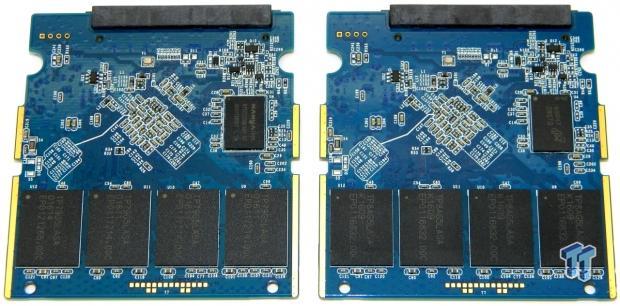
This side of the PCB houses an additional four flash packages and another DRAM cache package.

A detailed view of the Phison PS3110-S10-X quad-core, eight channel SATA III controller that powers the Neutron XTi.

A detailed view of one of the eight 64GB Toshiba 15nm MLC BGA flash packages that populate the PCB of the 480GB model.

A detailed view of one of the eight 128GB Toshiba 15nm MLC BGA flash packages that populate the PCB of the 960GB model.

A detailed view of one of the 480GB model's two NANYA branded 512MB DDR3 1600MHz cache packages.

A detailed view of one of the 960GB model's two Micron branded 1024MB DDR3 1600MHz cache packages.
Test System Setup and Properties
Jon's Consumer SSD Review Test System Specifications
- Motherboard: ASRock Extreme9 Z97 - Buy from Amazon
- CPU: Intel Core i7 4790K @ 4.8GHz - Buy from Amazon / Read our review
- Cooler: Swiftech H2O-320 Edge - Buy from Amazon / Read our review
- Memory: Corsair Dominator DDR3 32GB 2400MHz - Buy from Amazon
- Video Card: Onboard Video
- Case: IN WIN X-Frame - Buy from Amazon / Read our review
- Power Supply: Seasonic Platinum 1000 Watt Modular - Buy from Amazon / Read our review
- OS: Microsoft Windows 10 Professional 64-bit - Buy from Amazon
- Drivers: Intel RAID option ROM version 13.0.0.2075 and Intel RST driver version 13.6.0.1002
We would like to thank ASRock, Crucial, Intel, Corsair, RamCity, IN WIN, and Seasonic for making our test system possible.
Drive Properties
Corsair Neutron XTi 480GB OS Disk 75% Full

Corsair Neutron XTi 960GB OS Disk 75% Full

The majority of our testing is performed with our test drive as our boot volume. Our boot volume is 75% full for all OS Disk "C" drive testing to replicate a typical consumer OS volume implementation. We feel that most of you will be utilizing your SSDs for your boot volume and that presenting you with results from an OS volume is more relevant than presenting you with empty secondary volume results.
System settings: Cstates and Speed stepping are both disabled in our systems BIOS. Windows High-Performance power plan is enabled. Windows write caching is enabled, and Windows buffer flushing is disabled. We are utilizing Windows 10 Pro 64-bit OS for all of our testing except for our MOP (Maxed-Out Performance) benchmarks where we switch to Windows Server 2008 R2 64-bit.
Both capacities will be charted and we will present benchmark screenshots of the 960GB Neutron XTi.
Synthetic Benchmarks - ATTO & Anvil's
ATTO
Version and / or Patch Used: 2.47
ATTO is a timeless benchmark used to provide manufacturers with data used for marketing storage products.

Compressible sequential read/write transfers max out at 563/529 MB/s. Keep in mind this is our OS volume, and it is filled to 75% of its total capacity. Maximum sequential read performance is achieved at a 1MB transfer size, maximum sequential write performance at 256KB transfers. Sequential write performance comes in 10MB/s lower than factory specifications for the 960GB model. Although not shown with a screenshot, the 480GB model exceeds factory sequential specifications for both read and write.
Sequential Write

The 480GB Neutron XTi delivers better sequential write performance than the 960GB model. The 480GB model delivers the best sequential performance of the drive's in our test pool from 16KB to 8MB transfers. S10 powered SSDs have always delivered best in class sequential performance.
Sequential Read
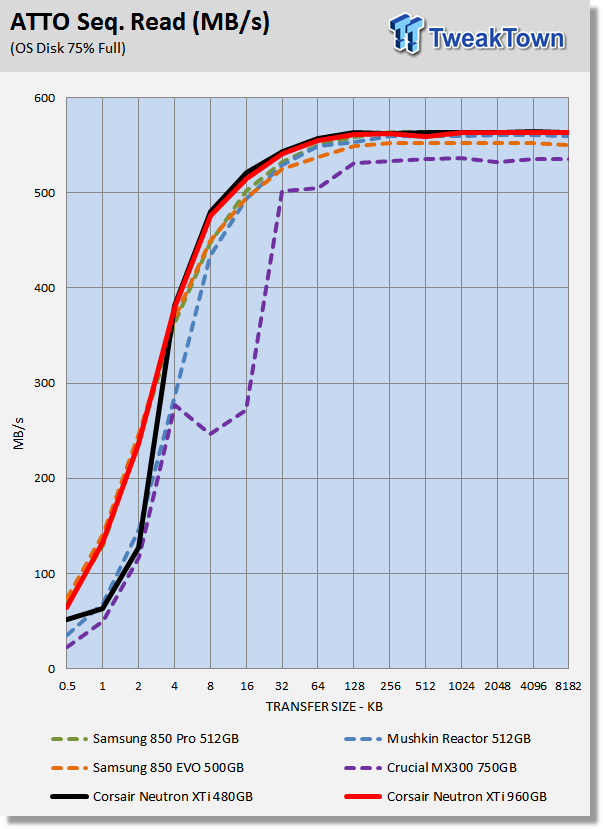
The 960GB Neutron XTi, overall, outperforms the field when reading sequential data. We note the especially strong small file performance of the 960GB model; it is much better than the 480GB model. We are surprised that the 960GB Neutron XTi is able to essentially match the small file performance of the 850 Pro and EVO.
Anvil Storage Utilities
Version and / or Patch Used: 1.1.0
Anvil's Storage Utilities is a storage benchmark designed to measure the storage performance of SSDs. The Standard Storage Benchmark performs a series of tests; you can run a full test or just the read or write test, or you can run a single test, i.e. 4k QD16.

Scoring

Anvil's scoring gives a good indication of a drive's overall performance. Both Neutron XTi capacity points score over 5000, which is always a good indication that a drive is capable of delivering top-notch performance.
(Anvil) Read IOPS through Queue Depth Scale

The Neutron's are both outperformed by Samsung's 850 Series SSDs, however, they both handily outperform Mushkin's Reactor.
(Anvil) Write IOPS through Queue Scale

Samsung's 850 series SSDs deliver the best performance up to QD8. At QD8-32 the 960GB Neutron XTi takes the lead.
Synthetic Benchmarks - CDM & AS SSD
CrystalDiskMark
Version and / or Patch Used: 3.0 Technical Preview
CrystalDiskMark is disk benchmark software that allows us to benchmark 4k and 4k queue depths with accuracy. Note: Crystal Disk Mark 3.0 Technical Preview was used for these tests since it offers the ability to measure native command queuing at QD4.


This backs up what we saw with Anvil's testing. Samsung's 850 series SSDs outperform the Neutron's, and the Neutron's handily outperform Crucial's MX300 and Mushkin's Reactor. The 480GB and 960GB Neutron's deliver almost identical performance.

The Neutron's outperform the field with sequential and 512K writes. QD4 and QD32 random performance is identical to the 850 Series SSDs. The 850 Series SSDs deliver superior QD1 performance. The Neutron's again handily outperform the MX300 and Reactor.
AS SSD
Version and / or Patch Used: 1.7.4739.38088
AS SSD determines the performance of SSDs. The tool contains four synthetic as well as three practice tests. The synthetic tests are to determine the sequential and random read and write performance of the SSD.


AS SSD is a demanding test and the Neutron's make short work of it. Both Neutron's outperform Samsung's 850 Pro, however, both are slightly outperformed by the 850 EVO. We consider a score of 1200 or better to be an elite score that very few SATA-based SSDs are capable of delivering when they are loaded up with data.
Benchmarks (Trace, OS Volume) - Vantage, PCMark 7 & PCMark 8
Moderate Workload Model
We categorize these tests as indicative of a moderate workload environment.
PCMark Vantage - Hard Disk Tests
Version and / or Patch Used: 1.2.0.0
The reason we like PCMark Vantage is because the recorded traces are played back without system stops. What we see is the raw performance of the drive. This allows us to see a marked difference between scoring that other trace-based benchmarks do not exhibit. An example of a marked difference in scoring on the same drive would be empty vs. filled vs. steady state.
We run Vantage three ways. The first run is with the OS drive 75% full to simulate a lightly used OS volume filled with data to an amount we feel is common for most users. The second run is with the OS volume written into a "Steady State" utilizing SNIA's guidelines. Steady state testing simulates a drive's performance similar to that of a drive that been subjected to consumer workloads for extensive amounts of time. The third run is a Vantage HDD test with the test drive attached as an empty, lightly used secondary device.
OS Volume 75% Full - Lightly Used

OS Volume 75% Full - Steady State

Secondary Volume Empty - FOB

There's a big difference between an empty drive, one that's 75% full/used, and one that's in a steady state.
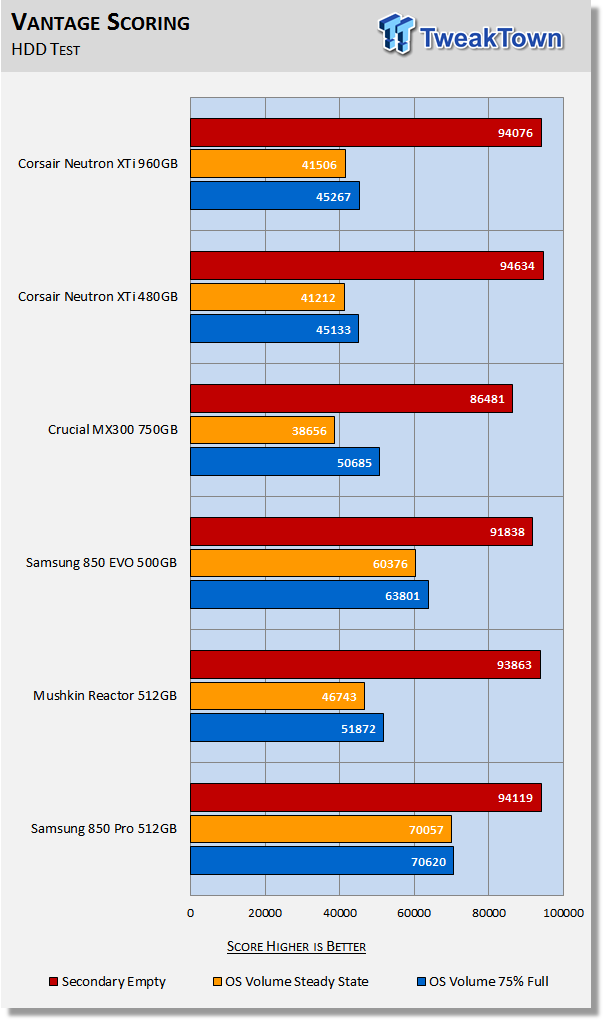
The important scores to pay attention to are "OS Volume Steady State" and "OS Volume 75% full." These two categories are most important because they are indicative of typical of consumer user states. When a drive is in a steady state, it means garbage collection is running at the same time it's reading/writing. This is exactly why we focus on steady state performance.
Phison S10 powered SSDs are capable of delivering class leading Vantage scores when empty. However, empty scores are meaningless which is THE reason we test the way we do. With data on the drives, a different picture emerges with the Neutron's only able to best the MX300 in a steady-state. We don't expect to see the advantage of double the DRAM cache until we hit our heavy workload testing. Phison S10 controlled SSDs have always done very well with heavy workloads and struggled a bit with moderate workloads in comparison to Samsung's 850 series SSDs.
PCMark 7 - System Storage
Version and / or Patch Used: 1.4.0
We will look to Raw System Storage scoring for evaluation because it's done without system stops and, therefore, allows us to see significant scoring differences between drives.
OS Volume 75% Full - Lightly Used

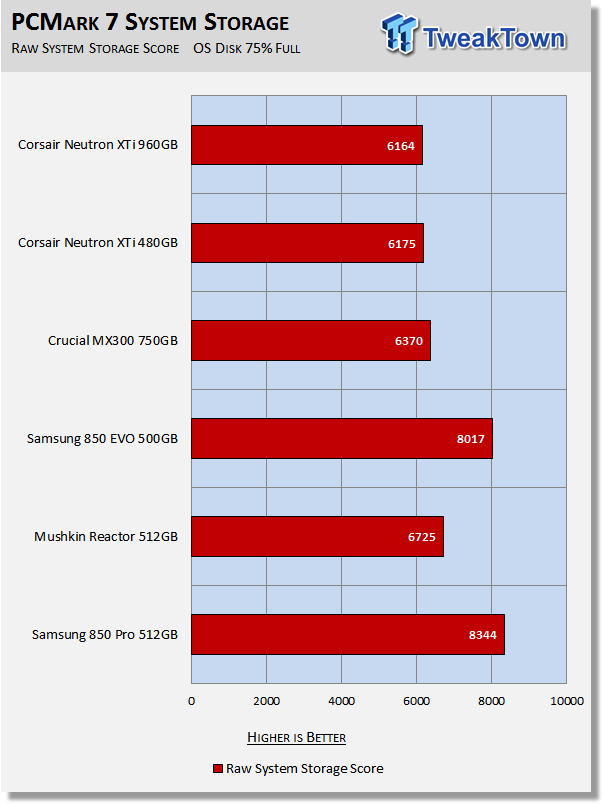
This time, the Neutrons fall to the bottom of our test pool. Performance still falls within what we consider a very acceptable range, but far below that of Samsung's 850 series SSDs.
PCMark 8 - Storage Bandwidth
Version and / or Patch Used: 2.4.304
We use PCMark 8 Storage benchmark to test the performance of SSDs, HDDs, and hybrid drives with traces recorded from Adobe Creative Suite, Microsoft Office, and a selection of popular games. You can test the system drive or any other recognized storage device, including local external drives. Unlike synthetic storage tests, the PCMark 8 Storage benchmark highlights real-world performance differences between storage devices.
OS Volume 75% Full - Lightly Used


PCMark 8 is the most intensive moderate workload simulation we run. With respect to moderate workloads, this test is what we consider the best indicator of a drive's performance. Samsung's 850 series SSDs dominate this testing. The rest of the drive's in our test pool deliver performance similar to one another.
Benchmarks (Secondary) - IOPS, Response & Transfers
Iometer - Maximum IOPS
Version and / or Patch Used: Iometer 2014
We use Iometer to measure high queue depth performance. (No Partition)
Max IOPS Read

Max IOPS Write


With our configuration, we hit Corsair's factory max 4K random specifications right on the money. The Neutron's outperform the field when tested as a secondary attached device in an FOB state.
Iometer - Disk Response
Version and / or Patch Used: Iometer 2014
We use Iometer to measure disk response times. Disk response times are measured at an industry accepted standard of 4K QD1 for both write and read. Each test runs twice for 30 seconds consecutively, with a 5-second ramp-up before each test. We partition the drive/array as a secondary device for this testing.
Avg. Write Response

Avg. Read Response


Samsung's 850 series deliver the lowest (best) read/write response. The Neutron's have lower (better) read response than the MX300 and Reactor, but higher (worse) write response than the rest of the drive's in our test pool.
DiskBench - Directory Copy
Version and / or Patch Used: 2.6.2.0
We use DiskBench to time a 28.6GB block (9,882 files in 1,247 folders) composed primarily of incompressible sequential and random data as it's transferred from our DC P3700 PCIe NVME SSD to our test drive. We then read from a 6GB zip file that's part of our 28.6GB data block to determine the test drive's read transfer rate. Our system is restarted prior to the read test to clear any cached data, ensuring an accurate test result.
Write Transfer Rate

Read Transfer Rate


The Neutron's transfer data at a very fast rate. Both capacities have a better read transfer rate than all but Samsung's 850 Pro. Both capacities have a better write transfer rate than Crucial's MX300, and Mushkin's Reactor.
Benchmarks (Secondary) - PCMark 8 Extended
Futuremark PCMark 8 Extended
Heavy Workload Model
PCMark 8's consistency test simulates an extended duration heavy workload environment. PCMark 8 has built-in, command line executed storage testing. The PCMark 8 Consistency test measures the performance consistency and the degradation tendency of a storage system.
The Storage test workloads are repeated. Between each repetition, the storage system is bombarded with a usage that causes degraded drive performance. In the first part of the test, the cycle continues until a steady degraded level of performance has been reached. (Steady State)
In the second part, the recovery of the system is tested by allowing the system to idle and measuring the performance after 5-minute long intervals. (Internal drive maintenance: Garbage Collection (GC)) The test reports the performance level at the start, the degraded steady-state, and the recovered state, as well as the number of iterations required to reach the degraded state and the recovered state.
We feel Futuremark's Consistency Test is the best test ever devised to show the true performance of solid state storage in an extended duration heavy workload environment. This test takes on average 13 to 17 hours to complete and writes somewhere between 450GB and 14,000GB of test data depending on the drive. If you want to know what an SSDs steady state performance is going to look like during a heavy workload, this test will show you.
Here's a breakdown of Futuremark's Consistency Test:
Precondition phase:
1. Write to the drive sequentially through up to the reported capacity with random data.
2. Write the drive through a second time (to take care of overprovisioning).
Degradation phase:
1. Run writes of random size between 8*512 and 2048*512 bytes on random offsets for 10 minutes.
2. Run performance test (one pass only).
3. Repeat 1 and 2 for 8 times, and on each pass increase the duration of random writes by 5 minutes.
Steady state phase:
1. Run writes of random size between 8*512 and 2048*512 bytes on random offsets for 50 minutes.
2. Run performance test (one pass only).
3. Repeat 1 and 2 for 5 times.
Recovery phase:
1. Idle for 5 minutes.
2. Run performance test (one pass only).
3. Repeat 1 and 2 for 5 times.
Storage Bandwidth
PCMark 8's Consistency test provides a ton of data output that we use to judge a drive's performance.

We consider steady state bandwidth (the blue bar) our test that carries the most weight in ranking a drive/arrays heavy workload performance. Performance after Garbage Collection (GC) (the orange and red bars) is what we consider the second most important consideration when ranking a drive's performance. Trace-based steady state testing is where true high performing SSDs are separated from the rest of the pack.
This test clearly displays the benefit of a larger DRAM cache. The Neutron's are able to accomplish what we had hoped for by handily outperforming Samsung's 850 Pro in a steady state, with a heavy workload. This is a big win for Corsair and serves as proof that the Neutron XTi is indeed a heavy workload powerhouse as advertised. It's not just steady state performance either, the Neutron's deliver better heavy workload performance than Samsung's 850 Pro across the board. Samsung's 850 EVO delivers the best performance after it cleans up, but it also suffers a beating when garbage collection is running while simultaneously reading/writing.

We chart our test subject's storage bandwidth as reported at each of the test's 18 trace iterations. This gives us a good visual perspective of how our test subjects perform as testing progresses. This chart sheds more light on how the drives perform as they progress through the testing phases.
Total Access Time (Latency)
We chart the total time the disk is accessed as reported at each of the test's 18 trace iterations.

Low latency translates to the real-world as snappiness. This explains why the Neutron XTi is one of the snappiest SSDs we've ever tested. The 850 Pro is the closest contender in terms of steady-state latency, and it doesn't even come close to matching the Neutron's ultra-low latency.
Disk Busy Time
Disk Busy Time is how long the disk is busy working. We chart the total time the disk is working as reported at each of the tests 18 trace iterations.

When latency is low, disk busy time is low as well.
Data Written
We measure the total amount of random data that our test drive/array is capable of writing during the degradation phases of the consistency test. Pre-conditioning data is not included in the total. The total combined time that degradation data is written to the drive/array is 470 minutes. This can be very telling. The better a drive/array can process a continuous stream of random data; the more data will be written.

Write latency, overprovisioning are the biggest factors that determine the outcome of this portion of the test. The Neutron's slaughter the competing drives in our test pool. The outcome of this test clearly shows that the Neutron's have better flash management during a heavy workload.
Benchmarks (Secondary) - 70/30 Mixed Workload
70/30 Mixed Workload Test (Sledgehammer)
Version and / or Patch Used: Iometer 2014
Heavy Workload Model
This test hammers a drive so hard we've dubbed it "Sledgehammer". Our 70/30 Mixed Workload test is designed to simulate a heavy-duty enthusiast/workstation steady-state environment. We feel that a mix of 70% read/30% write, full random 4K transfers best represents this type of user environment. Our test allows us to see the drive enter into and reach a steady state as the test progresses.
Phase one of the test preconditions the drive for 1 hour with 128K sequential writes. Phase two of the test runs a 70% read/30% write, full random 4K transfer workload on the drive for 1 hour. We log and chart (phase two) IOPS data at 5-second intervals for 1 hour (720 data points). 60 data points = 5 minutes.

What we like about this test is that it reflects reality. Everything lines up, as it should. Consumer drives don't outperform Enterprise-Class SSDs that were designed for enterprise workloads. Consumer drives based on old technology are not outperforming modern Performance-Class SSDs, etc.
More evidence that double the DRAM cache definitely benefits heavy workload scenarios. Although not charted, previously tested S10 powered SSDs do not display the tight consistent pattern we are seeing from the Neutron's; they instead display a pattern similar to what we see from Mushkin's Reactor. The Neutron's again handily outperform Samsung's 850 series SSDs.
Maxed-Out Performance (MOP)
This testing is just to see what the drive is capable of in an FOB (Fresh Out of Box) state under optimal conditions. We are utilizing Windows Server 2008 R2 64-bit for this testing. Same Hardware, just an OS change.
Corsair Neutron XTi 480GB
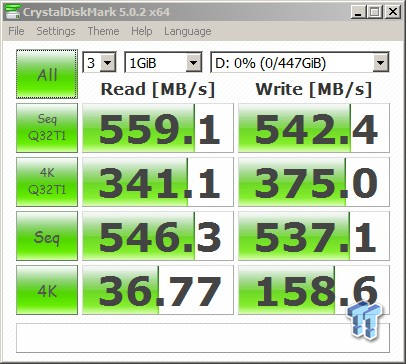

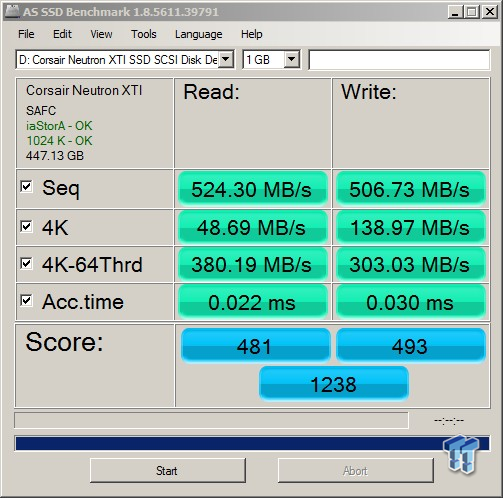

Corsair Neutron XTi 960GB




Final Thoughts

Corsair seems to be coming back and making a real presence with premium products. Their new Neutron XTi flagship SATA III SSD is a prime example of this. Corsair decided to go in the opposite direction with this SSD by not reducing or eliminating the onboard DRAM cache for better profit margins, but instead doubling it for better performance. We believe the gamble will pay off for Corsair and help to enlarge their SSD market share.
We believe it is important to support the smaller guy's if they can deliver competitive products. Big corporations are just going to cut corners to make more profit margin; without the smaller guy's there is no resistance. We need more enthusiast companies back in the game or DRAM-less and BGA SSD days are nigh. Not good for the DIY market populated by PC enthusiasts who are always-on the lookout for a performance upgrade they can perform themselves.
We didn't think that Corsair's Neutron XTi would be able to challenge Samsung's 850 Pro in any meaningful way because it's such a monumental feat, but we were wrong about that. The Neutron XTi was able to significantly outperform Samsung's juggernaut when subjected to heavy workloads that simulate common user states for many enthusiast and workstation users. Does more DRAM cache make a difference? You bet it does.
We are also pleased with the MSRP of Corsair's Neutron XTi. Despite the additional production costs incurred by doubling the Neutron XTi's onboard DRAM cache, it will be selling from day one for about $40-$50 less than an 850 Pro of a similar capacity point.
What's inside is further complimented by what's on the outside. We love the Neutron XTI's bright red enclosure. It possesses a flashiness that will compliment many an enthusiasts' custom build. Overall the build quality is top notch, and the drive has a quality feel to it. Corsair's SSD Toolbox is one of the best in the business and is a nice value add; it even supports drive cloning.
Running Corsair's Neutron XTi as our OS disk was a very pleasurable experience. The drive is responsive, boots like lightning, and handles multi-tasking with ease. Overall the Corsair Neutron XTi delivers a tier one SSD experience.
Corsair's Neutron XTi 480GB and 960GB SATA III SSDs are both TweakTown recommended.
Pros:
- Low Cost
- MLC Flash
- Heavy Workloads
- Five-Year Warranty
Cons:
- Moderate Workload

